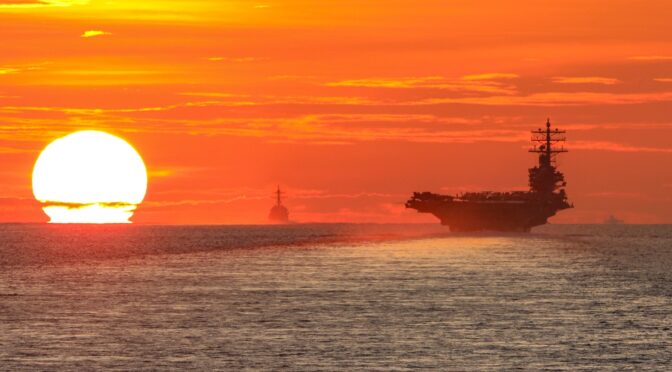By Dmitry Filipoff
CIMSEC had an outstanding year in 2023. Numerous authors took to CIMSEC to offer compelling insights and analysis on a broad range of maritime security topics and naval affairs. We are continually grateful to our readership for following and contributing to the conversation on our pages. To close out the year, we are highlighting the top 10 CIMSEC articles of 2023, listed below in order of most viewed.
On behalf of the CIMSEC team, we hope you enjoy the holidays, and we look forward to continuing the conversation in an exciting new year.
_________________________________________
1. “An Allied Coast Guard Approach to Countering CCP Maritime Gray Zone Coercion,” by Jada Fraser
“An analysis of recent reforms to Japan’s coast guard presents several models that the USCG can build off. Such an approach recognizes current U.S. resource limitations and accounts for how an important U.S. ally at the forefront of countering CCG gray zone activities has pursued its own reforms, even while under similar and additional constraints.”
2. “A Fleet Adrift: The Mounting Risks of the U.S. Navy’s Force Development,” by Dmitry Filipoff
“Overall, the Navy’s major exercises often took a scripted character, where the outcomes were generally known beforehand and the opposition was usually made to lose. Training only one thing at a time against opposition that never wins barely scratches the surface of war, but for the most part this was the best the Navy could do to train its strike groups for years.”
3. “Fighting DMO, Pt. 8: China’s Anti-Ship Firepower and Mass Firing Schemes,” by Dmitry Filipoff
“As both great powers build up and evolve their anti-ship firepower, it is critical to assess their respective schemes of massing fires, and how these schemes may compete and interact in a specific operational context, such as a war sparked by a Taiwan contingency. Whichever side wields the superior combination of tools and methods for massing fires may earn a major advantage in deterrence and in conflict.”
4. “Tankers For The Pacific Fight: A Crisis in Capability,” by Stephen M. Carmel
“Not only does the U.S. lack the tonnage required to support a major conflict in the Pacific, it has no identifiable roadmap to obtain it. Without enough fuel, the most advanced capabilities and ships – even nuclear-powered aircraft carriers – will hardly be available for use. This is a crisis in capability that requires urgent and effective action.”
5. “Winning High-End War at Sea: Insights into the PLA Navy’s New Strategic Concept,” by Ryan D. Martinson
“Perhaps no one source of information is more valuable than Chinese media coverage of an important—but largely unknown—conference of PLAN admirals held at the end of 2022, in the wake of the Chinese Communist Party’s 20th Party Congress. The available reporting on the conference sheds light on how to better understand how the PLAN sees its strategic priorities.”
6. “Fighting DMO, Pt. 1: Defining Distributed Maritime Operations and the Future of Naval Warfare,” by Dmitry Filipoff
“Distributed Maritime Operations can provide a framework for understanding modern naval warfare and illuminate its future. While plenty of unknowns remain, the DMO concept offers an important opportunity to foster debate on how to adapt naval warfighting and translate theory into practice.”
7. “Fighting DMO, Pt. 2: Anti-Ship Firepower and the Major Limits of the American Naval Arsenal,” by Dmitry Filipoff
“The ability to mass fires is fundamentally enabled by fielding a large number of long-range missiles across a wide variety of platforms. In terms of numbers, range, and variety, the U.S. military falls woefully short. The U.S. military cannot execute the tactic of distributed massed fires against warships today because it simply does not have the weapons to make it possible. Its current anti-ship missile firepower is extremely concentrated in aircraft carriers and tightly stretched thin everywhere else.”
8. “Island Blitz: A Campaign Analysis of a Taiwan Takeover by the PLA,” by Max Stewart
“This campaign analysis seeks to determine how long U.S. decision-makers can realistically have those debates before the PLA seizes Taipei and the window for effective intervention with military force has closed. It does so by employing analytical modeling, informed by historical data, to determine how long the Taiwanese can resist a Chinese invasion absent direct U.S. military intervention given best-case-scenario timelines for the PLA.”
9. “Fighting DMO, Pt. 7: The Future of the Aircraft Carrier in Distributed Warfighting,” by Dmitry Filipoff
“For distributed warfighting at sea, there is a clear argument to be made for the vital role of naval aviation, whether it must come from aircraft carriers or somewhere else. Some of these arguments are couched in the fact that many of the premier weapons of modern naval warfare are themselves fast airborne payloads, that warships are mostly blind to spaces of enormous tactical consequence, and that air superiority is a powerful enabler of information superiority.”
10. “Cuban Missile Crisis: Soviet Submarines Attack?” by LtCol Brent Stricker
“Vague orders on the use of nuclear tipped torpedoes and the heat and confusion might have caused a local commander to launch these weapons, dragging two nuclear powers into an escalating exchange both desperately wanted to avoid. This potentially escalatory exchange at a pivotal moment in the Cuban Missile Crisis offers a cautionary tale for the continuing conflict in Ukraine.”
Dmitry Filipoff is CIMSEC’s Director of Online Content. Contact him at Content@cimsec.org.
Featured Image: The aircraft carrier USS Ronald Reagan (CVN 76) transits the South China Sea on June 18, 2021, with the Arleigh Burke-class guided missile destroyer USS Halsey (DDG 97) and the Ticonderoga-class guided-missile cruiser USS Shiloh (CG 67). (MC1 Rawad Madanat/Navy)


